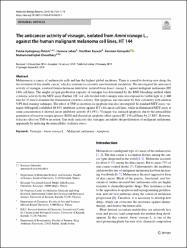The anticancer activity of visnagin, isolated from Ammi visnaga L., against the human malignant melanoma cell lines, HT 144

View/
Date
2019Author
Aydoğmuş-Öztürk, FatmaJahan, Humera
Beyazıt, Neslihan
Günaydın, Keriman
Choudhary, Muhammad Iqbal
Metadata
Show full item recordAbstract
Melanoma is a cancer of melanocyte cells and has the highest global incidence. There is a need to develop new drugs for the treatment of this deadly cancer, which is resistant to currently used treatment modalities. We investigated the anticancer activity of visnagin, a natural furanochromone derivative, isolated from Ammi visnaga L., against malignant melanoma (HT 144)cell lines. The singlet oxygen production capacity of visnagin was determined by the RNO bleaching method while cytotoxic activity by theMTT assay. Further, HT 144 cells treated with visnagin were alsoexposed to visible light (400 nm) for 25min to examine the illuminationcytotoxicactivity.The apoptosis was measured by flow cytometry with annexin V/PI dual staining technique. The effect of TNF-secretion on apoptosis was also investigated. In standard MTT assay, visnagin (100 mu g/mL) exhibited 80.93% inhibitory activity against HT 144 cancer celllines, while in illuminated MTT assayat same concentration it showed lesser inhibitory activity (63.19%). Visnagin was induced apoptosis due to the intracellular generation of reactive oxygen species (ROS) andshowed an apoptotic effect against HT 144 cell lines by 25.88%. However, it has no effect on TNF- secretion. Our study indicates that visnagin can inhibit the proliferation of malignant melanoma, apparently by inducing the intracellular oxidative stress.

















